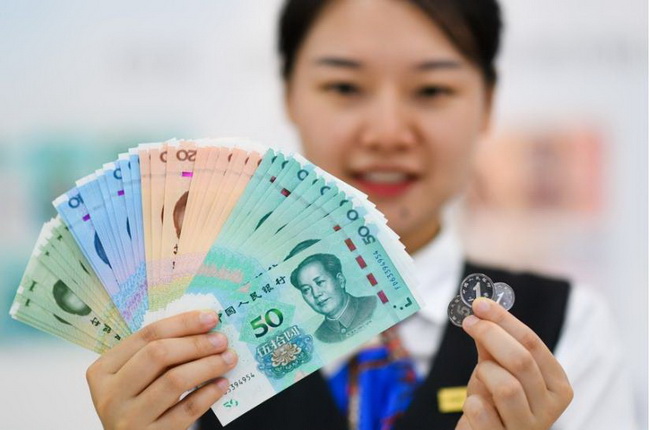RMB appreciation boosts attractiveness of assets investment

A staff member displays the banknotes and coins included in the 2019 edition of the fifth series of the renminbi at an Industial and Commercial Bank of China (ICBC) branch in Beijing, capital of China, Aug. 30, 2019. (Xinhua/Chen Yehua)
The renminbi (RMB) exchange rate has appreciated rapidly recently.
This reflects the changes in market supply and demand, as well as the increased flexibility of the exchange rate, said market analysts who believe the RMB exchange rate will remain basically stable amid two-way fluctuations, and the RMB assets boast long-term attractiveness for invesmtent.
-- Speedy appreciation
The appreciation of the RMB exchange rate has quietly sped up entering May. On May 10, the spot exchange rate of onshore RMB against the U.S. dollar surged to 6.42 yuan and closed at 6.4173 yuan at 16:30, up 416 points from the previous trading day and hitting a new high since June 2018.
The central parity rate of RMB against the U.S. dollar was reported at 6.4425 yuan on the same day, the highest since February 18 this year.
On May 6 and 7, the offshore RMB exchange rate has appreciated successively, recording 6.4049 yuan as of 18:30 on May 10. In just three trading days, the offshore RMB exchange rate rose by more than 800 points.
According to statistics, compared with the low point at the end of March this year, the current onshore RMB exchange rate has rebounded by more than 1,600 points, and the offshore RMB exchange rate by more than 1,800 points.
Industry insiders said that due to U.S. Federal Reserve (Fed)'s repeated efforts to dampen policy tightening expectations, especially the unexpectedly dismal U.S. non-farm payrolls data disclosed recently, the major non-U.S. currencies have appreciated against the U.S. dollar to varying degrees, among which RMB is a relatively prominent one as the RMB exchange rate is further supported by fundamentals.
Data from the General Administration of Customs (GAC) of China showed that China's trade surplus in April this year was much higher than the market estimate, and the accumulated trade surplus in the first four months set a new record for the same period in history.
-- Further space for appreciation in the short term
In the view of related institutions, the RMB exchange rate may further rise in the short run.
On the one hand, many industry insiders expect that the U.S. dollar's decline may continue. A survey on foreign exchange strategy analysts in early May showed the U.S. dollar is likely to underperform against most major currencies in the coming year.
On the other hand, the RMB will continue to be supported by a large trade surplus. Meanwhile, the RMB exchange rate will be supported by capital inflows with the slowdown or falling of the rise in U.S. Treasury securities yields and the slight widening of China-U.S. interest rate spreads.
There is still a spread of nearly 160 basis points between the 10-year U.S. Treasury securities yields which has leveled off at 1.6 percent recently, and the 10-year China treasury bond yields which is around 3.15 percent, well above the average since 2000.
In the longer term, the existence of uncertainties cannot be ignored, and there are risks in betting on the unilateral appreciation of the RMB exchange rate.
Analysts pointed out that in the context of global economic recovery, the Fed's policy expectations are gradually changing, and the trend of the U.S. dollar is still uncertain. It may be difficult for the RMB exchange rate to repeat the unilateral appreciation that happened in the second half of 2020.
Industry insiders said that although the disturbance brought by the U.S. dollar may be unavoidable, the fundamentals will continue to provide support for the RMB exchange rate which is expected to remain basically stable in the two-way fluctuations.
According to them, the fluctuations in the RMB exchange rate over the past two months reflect the increased flexibility and the resilience of the exchange rate.
-- Improving attractiveness of RMB assets
In the view of market participants, a stable and stronger RMB exchange rate will further enhance the attractiveness of investment in RMB assets.
The latest data showed that after a brief pullback in March, foreign institutions again accelerate the investment in China treasury bonds in April as U.S. Treasury securities yields eased and the RMB resumed its appreciation.
According to data released on May 10 by China Foreign Exchange Trade System (CFETS), a sub-institution directly affiliated to the People's Bank of China (PBC), foreign institutional investors bought 516.9 billion yuan of bonds in the interbank market in April and sold 386.2 billion yuan of such bonds, making a net purchase of 130.8 billion yuan.
By the end of April, 478 foreign institutional investors had entered the market through the settlement agent mode, and 652 foreign institutional investors had entered the market through the bond connect model.
In the stock market, according to statistics, as of May 10, this year's accumulated net purchases of money invested from Hong Kong into the Chinese mainland through the stock connect programs reached 157.6 billion yuan.
In each of the first four months, the net purchases of such funds all exceeded 10 billion yuan.
In the three trading days since May, the accumulated net purchases of such funds notched 5.1 billion yuan, and on May 10 only, the net purchases amounted to 4.5 billion yuan.
Market participants pointed out that the change in the intensity of foreign institutions' debt allocation partly reflected the impact of the RMB exchange rate on their investment behavior.
The stabilization of the RMB exchange rate could ease foreign investors' concerns about investing in RMB assets. Given the good performance of the Chinese economy and the earlier normalization of China's monetary policy, the price-performance ratio of RMB assets has been further highlighted.


